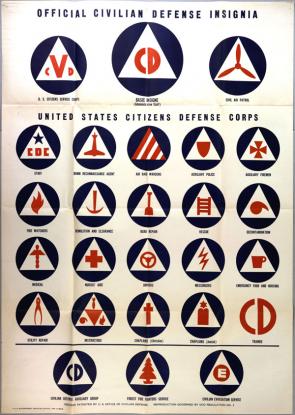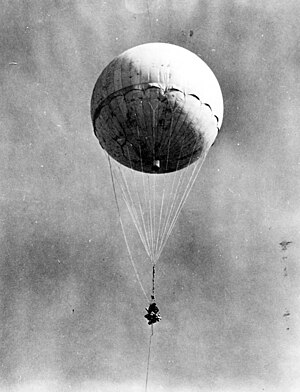The Japanese attack on Pearl Harbor and U.S.’s declaration of war changed all that. The loss of American lives changed the public opinion in favor of war, and many Americans were eager to help in any way they could. Fear of attack spread throughout the nation, especially on the East and West coast. The OCD was soon overwhelmed with volunteers, and the Citizens Defense Corps were established to train specialists as air raid wardens, auxiliary firemen, auxiliary police, emergency food and housing personnel, fire watchers, medical corps, etc. Specialists wore special insignia identifying their area of expertise, with symbols for each unit inscribed in the OCD’s white triangle emblem. Communities participated as a whole, with “block leaders” responsible for keeping their designated area contributing to the war effort by seeking workers for factories, promoting war bonds, and collecting helpful information. The Junior Service Corps were formed for children, who helped their communities by doing scrap drives of used pots and rubber tires (made of materials needed for the war industry) and promoting the sale of war bonds. The OCD provided the public with survival guides, such as “Handbook for Air Raid Wardens” and “What can I do? The Citizen’s handbook for war”, and printing many posters to promote the OCD.

One of the first units created by the OCD was the Aircraft Warning Service (AWS). The main goal was to protect coastal regions from air attacks, but there wasn’t enough radar equipment to protect the entire coast, so volunteer “spotters” were recruited to keep a watch out for enemy planes. Volunteers organized the Coast Guard Auxiliary to aid the existing Coast Guard Reserves to patrol the seas and protect ports and trade routes from sabotage. Almost all Auxiliary boats were private owned, with CGA pained on their bows to distinguish them from civilian vessels. In addition, the Civil Air Patrol (CAP) was created to recruit private pilots to protect the nation from the air. Serving as messengers and reconnaissance at first, CAP planes were eventually equipped with bombs with depth charges to seek out and attack German submarines. CAP pilots were known as the Flying Minutemen of WW2, a reference to the private militia of the American Revolution. CAP planes spotted 173 submarines, and attacked 57, and logged millions of flight hours patrolling the coasts. In recognition, President Roosevelt made CAP a formal auxiliary in the U.S. Army Air Force.

While several limited attacks took place on the West Coast by the Japanese, US government made sure to limit their publicity. The first sign of aggression came when a Japanese submarine shelled a coastal oil field in the vicinity of Santa Barbara, and later a fort in Oregon. With enemy submarines appearing on both coasts, Dim-out rules were passed by the OCD, prohibiting car drivers or lights to be shone at the ocean within 16 miles of the coast in some areas. Blackout drills were also required, with San Francisco having 7 of them in the first month after Pearl Harbor. Japanese attempted to drop some fire staring bombs in Oregon, but failed to do much damage in the long run. Instead, Japanese military constructed hydrogen balloons that floated bombs all the way across the Pacific Ocean using air currents to drop them on the West coast, with some flying inland as far as Chicago. One such undetonated bomb was disturbed by civilians, causing the only six casualties caused by attack on the mainland of America in WW2. The Japanese stopped the production of balloons by the spring of 1945, with the last seen balloon causing a blackout on in an government nuclear reactor in Washington, which would ironically provide plutonium for the bomb that would hit Nagasaki several months later.

Sources:
No comments:
Post a Comment
Note: Only a member of this blog may post a comment.